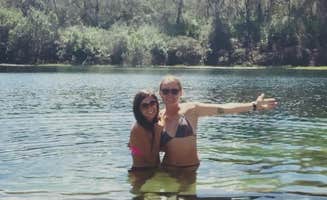Dispersed camping near Astor, Florida centers on the 387,000-acre Ocala National Forest, where sandy soil conditions create challenging driving situations during wet weather. The subtropical climate brings hot, humid summers with temperatures regularly exceeding 90°F and mild winters with occasional frost. Seasonal flooding can affect access points along the Ocklawaha and St. Johns Rivers, particularly during summer rainy season from June through September when afternoon thunderstorms are common.
What to do
Wildlife viewing opportunities: Davenport Landing offers excellent opportunities to spot native Florida wildlife. One visitor noted, "For fellow arborists, in addition to finding these amazing Magnolias that seem to be especially planted here for you, additionally there's sweetgum and red maple trees." The area also attracts diverse bird species and river wildlife.
Fishing access points: Several dispersed sites provide direct river access for fishing enthusiasts. At Freak Creek Dispersed Camping, one camper shared, "There is a nice creek area where you can swim and or fish if you have the right equipment to get back there it can be fun." Catfish, bass, and panfish are common catches in the waterways.
Historical exploration: Some camping areas contain remnants of Florida's past. At Davenport Landing, a reviewer discovered, "If you have an explorer's mindset, you'll be richly rewarded here as there is a small gravesite from the Civil War that you can find along with middens along the Ocklawaha River hiding traces of the Timucuan Indians that once populated this area."
What campers like
Natural shade coverage: The forest canopy provides relief from the Florida heat at many sites. A camper at Davenport Landing appreciated the "dozen or so medium-sized Magnolias that blot out the sun's rays," which creates comfortable daytime temperatures even during summer months.
Paddling opportunities: St. Johns River Dispersed Spot provides excellent water access for kayakers and canoeists. A visitor mentioned it's "Right next to the river and the trees open up so you get a great view of the stars," making it ideal for both water recreation and night sky viewing.
Secluded camping experiences: Many sites offer genuine isolation from crowds. A visitor to Freak Creek noted it's "super secluded and quiet. Depending when you stay there's at times people who show up to party and then leave." This seclusion creates opportunities for genuine wilderness experiences within driving distance of populated areas.
What you should know
Vehicle requirements vary significantly: Each site has specific access challenges. At Trout Lake Primitive Sites, a camper warned about "Very narrow trails but really easy access, you will leave with some new pinstripes." Another camper explained, "The trail to the lake is so narrow I wasn't sure I was driving my Chevy Malibu through the forest because it was so overgrown."
Seasonal road conditions: During wet periods, sand and soil conditions deteriorate rapidly. One Davenport Landing reviewer noted, "The ground here is flat but barren and comprised of a combination of dirt and sand silt, which isn't so bad when it's dry, but when there's rain, we're talking some pretty messy mud-like conditions."
Complete lack of facilities: All sites require total self-sufficiency. A Davenport Landing camper emphasized, "No picnic tables. No fire ring. No stand-up grill. No potable water spigot. Nothing." Visitors must pack in all necessary supplies including drinking water and sanitation equipment.
Tips for camping with families
Safety precautions: Wildlife encounters require appropriate preparation. At Davenport Landing, visitors warned to "be on the look-out for 'Coyo-Dogs' (a cross between canine species where a dog mates with a coyote) and black bear, both of which have been known to frequent this area, especially at night."
Vehicle selection matters: Family camping requires careful planning for vehicle access. At Blue Sink, one visitor advised, "You may need ATV or creative backpacking to get there now. The Forestry Service recently chopped down trees and covered the easy access roads."
Consider shorter stays: The primitive nature of these sites can be challenging for extended family visits. A Trout Lake camper shared their experience: "I started panicking and trying to find a turn around after going through a very soft sandy spot. Figured I'd never be able to get out or reverse." Planning escape routes and having emergency supplies is essential.
Tips from RVers
Size restrictions are significant: Large RVs cannot access most dispersed sites. A Freak Creek camper advised, "I would not attempt bringing a camper unless it's really small." Standard recreational vehicles generally cannot navigate the narrow forest roads and clearance issues.
Tow vehicle requirements: Having appropriate recovery equipment is essential. A Freak Creek visitor warned, "If you don't have 4wd and recovery gear I wouldn't risk it." Getting stuck in remote areas with limited cell service creates dangerous situations, particularly for larger vehicles.
Scout locations first: When possible, explore sites without your RV before attempting access. At Davenport Landing, a camper noted the "last 100 yards driving back in were very bumpy but no problem with our van. Not sure about a larger RV." Smaller class B campervans may navigate some areas that larger motorhomes cannot.




